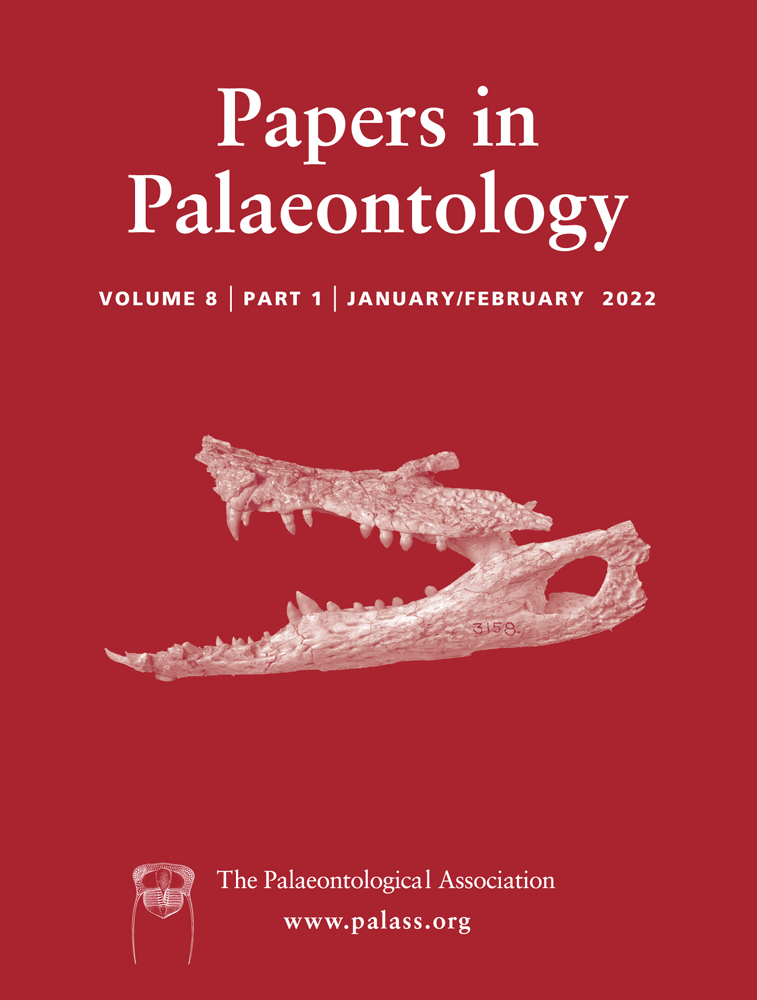High diversity of siliceous sponges in Western Tethyan areas during the Eocene: palaeobiogeographical, ecological and taxonomic significance
Abstract
Porifera is a clade of globally distributed, early diverging metazoans that are important components of modern aquatic environments. Despite the fact that they were also abundant in the geological past, their fossil record is uneven. For example, little is known about sponge communities that inhabited the Tethyan areas during the Cenozoic. Here, we record an abundant and taxonomically diverse assemblage of middle–late Eocene sponges from east-central Ukraine. The material consists of preserved whole-body specimens as well as disassociated spicules. The taxonomic composition of this new assemblage, supplemented with previously published data obtained from sponge materials originating from the middle and upper Eocene of the East European Platform, documents a surprisingly rich sponge community that inhabited shallow waters (depths of 100 m) and comprised at least 30 demosponge species, including two new taxa, Paratetilla milanek Łukowiak and Theonella alexandriae Łukowiak, three hexactinellids and a single homoscleromorph. Additionally, we report the first fossil occurrence of Vetulina, a demosponge genus that currently is found near the Philippines and Australia and in the Caribbean Sea. Some of the sponge taxa recognized were previously noted from the upper Eocene of Australia and New Zealand. This is indicative of their wide distribution during the early Cenozoic and also shows that a non-interrupted connection existed between the western Tethyan and peri-Australian areas, explaining the patchy distribution of some sponge taxa in modern seas.
Sponges (Porifera) form a species-rich and globally dispersed clade of earliest-diverging metazoans that occur in both marine and freshwater settings. They range from shallow waters of the eulittoral zone down to hadal depths, from the tropics to high latitudes (van Soest et al. 2012). Some sponge species are cosmopolitan, while others are regionally or locally restricted, which can be explained by the limited swimming abilities of most sponge larvae.
In the geological record, sponge bodies and their disassociated spicules are moderately common and diverse; they are used for reconstructions of past sponge communities (e.g. Bertolino et al. 2017; Łukowiak et al. 2018). Their spicules alone, in turn, often serve as indicators of the habitat conditions that the spicule-bearing sponges preferred (for a recent review, see Łukowiak 2020).
The richest assemblages of Eocene sponge spicules and body-fossils described to date are those from the upper Eocene of New Zealand (Hinde & Holmes 1892) and southern Australia (Hinde 1910; Pisera & Bitner 2007; Łukowiak 2015, 2016a; Łukowiak & Pisera 2017). These represent abundant and diverse sponge communities. However, sponges of the Tethyan areas in Europe are rather poorly known and have only rarely been described in detail.
During the Cretaceous and early Palaeogene, the ancient Tethys Ocean covered a considerable area that subsequently broke apart into five biogeographical provinces: East Pacific, West Atlantic, East Atlantic, Mediterranean and Indo-West Pacific, and was an area of uninterrupted migration of marine species until the end of the Eocene, when the intracontinental convergence closed the Tethys north of the Indian Plate (Hou & Li 2018 and the references therein).
Only a few studies have dealt with sponge body fossils from the Eocene of the European Tethyan areas. Menin (1972), Matteucci & Russo (2005, 2012), and Frisone et al. (2016) provided descriptions of some of the Eocene sponges from Italy. Reports of dissociated sponge spicules from the Eocene of Tethys are equally rare (e.g. Frisone et al. 2014). Here, we record a new and diverse assemblage of both sponge body fossils and dissociated spicules from the middle and upper Eocene of east-central Ukraine.
Several previous studies have recorded isolated sponge spicules from Ukraine but their presence was only briefly mentioned (Oszczypko et al. 2006; Szydło et al. 2014; Berezovsky 2015; Olshtynska & Stefanska 2016) or they were described parataxonomically (Ivanik 2003). Stefanska (2015) recorded material of several Eocene demosponge and hexactinellid families from the Kobelyaki area but provided only general illustrations of the skeletal elements described. Pisera (2000) published four body fossils of lithistid demosponges from the Eocene of Zaprozhnoye, south-east Ukraine. Recently, Łukowiak et al. (2019) have redescribed the Palaeogene siliceous sponge fauna of the East European Platform that was first reported in the parataxonomic study of Ivanik (2003). Łukowiak et al. (2019) documented the presence of a rich sponge assemblage, consisting of at least 24 demosponge families, one homoscleromorph and at least one hexactinellid.
Here we compile data from Łukowiak et al. (2019) with those of the present study, which encompasses a surprisingly rich and highly diverse Tethyan sponge fauna of Eocene age. Additionally, we record a body fossil of Aphrocallistes from museum collections. The sponge communities are here assessed in terms of their environmental preferences and compared with Eocene sponge faunas of the southern hemisphere. Additionally, we discuss their biogeographical significance and reconstruct palaeogeographic ranges of some taxa in the middle–late Eocene.
Geological setting
As a result of a very high sealevel caused by sea-floor spreading during the early Eocene, a considerable part of Europe (including Ukraine) was covered by a shallow epicontinental Tethys Sea (Briggs 1995). This explains why middle–upper Eocene deposits are widely distributed in the territory of present-day Ukraine. The deposits with sponges occur in the middle–upper Eocene of the central Ukraine region, and represent the Kiev (Lutetian–Bartonian) and Obukhov formations (Priabonian). The stratigraphy of these deposits was discussed in detail by Makarenko (1987), to which reference is made. The present sponge body fossils and disassociated spicules have been collected at the following localities: Kiev region (middle Eocene), Kropyvnitskyi area (village of Verblyuzhka, middle–upper Eocene), Vizirka quarry (middle Eocene), Rybalsky quarry (upper Eocene) and boreholes no. 1 (Ivanovka, upper Eocene), no. 3 (Spasskoye, middle and upper Eocene) and no. 143 (upper Eocene) (Fig. 1).
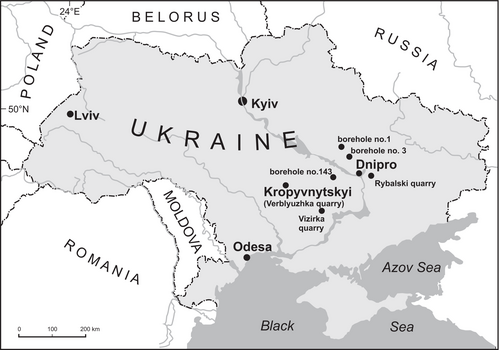
Kiev
An historical outcrop (now inaccessible) of the middle Eocene blue clays along the Dnieper River yielded pyritized and three-dimensionally preserved specimens of the hexactinellid genus Aphrocallistes Gray, 1858.
Kropyvnitskyi (village of Verblyuzhka)
Located in this area are green–grey, sandy gaizes of middle Eocene age with a rich fauna of shallow water foraminifera and molluscs, bryozoans, balanid cirripedes and echinoids (Stefanskyi et al. 2018). Sponges and spicules are very common and belong to both ‘soft’ demosponges as well as to lithistids; the latter may be rock forming in some places. Unfortunately, their preservation is very poor, most siliceous skeletons having been dissolved during secondary chert-like silicification that obscured their structure and made taxonomic assignment in most cases impossible. Historically, upper Eocene levels (now gone) cropped out in this area and yielded some well-preserved lithistids.
Rybalski quarry
Only upper Eocene deposits (Obukhov Formation) occur in this locality (Stefanskyi & Stefanska 2015), the lower portion of which is referred to as the Mandrikovka layer. This is a shallow water yellowish grey, detrital, non-glauconitic clayey sand rich in well-preserved faunas of foraminifera, corals, molluscs, brachiopods, fish otoliths and rhodoliths (Müller & Rozenberg 2003; Amitrov & Zhegallo 2007; Armitrov 2008; Berezovsky 2014, 2015; Sirenko & Dell’Angelo 2015; Bitner & Müller 2017). Overlying this unit are dark grey–green and brown silty sands and clays, often glauconitic and very rich in siliceous sponge spicules and fragments of lithistid sponges (Berezovsky 2015; Stefanskyi & Stefanska 2015). These rocks have yielded most of the present spicule material.
Borehole no. 1 (Ivanovka)
Upper Eocene levels are represented by green, fine-grained, poorly lithified glauconitic sandstones that contain abundant siliceous sponge spicules (Stefanska 2015).
Borehole no. 3 (village of Spasskoye)
This borehole penetrated middle and upper Eocene deposits. The middle Eocene level is represented by light grey siltstones with sponge spicules and fragments of hexactinellid skeletons (Ivanova & Stefanskyi 2013). The upper Eocene strata comprise greenish-grey sands and siltstones with glauconite and phosphorite grains, in places with an abundance of transparent spicules and fragments of lithistid and hexactinellid sponges.
Borehole no. 143
The upper Eocene Obukhov Formation is represented by green–grey glauconitic sands with numerous sponge spicules (Ivanova 2014).
Vizirka quarry
This is an iron ore quarry situated in the western outskirts of the city of Ingulets at which middle Eocene deposits are found below the Oligocene strata. The Eocene is represented by greenish-grey calcareous sandy clays with numerous nodules and layers of silicification that are assigned to the Kiev Formation. The clays contain a rich nummulitid assemblage, as well as small foraminifera, molluscs, ostracods, sponge spicules and other biogenic detritus. Calcareous nannoplankton is common. Sponge spicules are common in the lower part of the section.
Material and method
Samples were collected by two of us (TS and VS) in east-central Ukraine in 2014. The samples include both sponge body fossils and spicule-rich sedimentary rocks.
We have only a single, well-preserved demosponge body fossil (c. 10 mm in diameter) and several small sponge clumps/clusters of average size (10 × 10 × 20 mm), which do not preserve the original sponge shape, available. Sponge spicules, all well preserved, were extracted from spicule-rich rocks. In most cases, spicules are preserved in their original opaline composition. Preserved whole-body sponges from the so-called blue clays near Kiev were pyritized; those found in boreholes were either pyritized or partially pyritized.
Approximately 30 sediment samples, of variable volume (between 10 and 30 g), were taken for spicule analysis. Samples were macerated in the laboratory using hydrogen peroxide (H2O2, 30%) to remove organic matter and to cleanse and separate spicules. Subsequently, spicules were handpicked under a binocular microscope (Nikon SMZ800). We did not use a defined weight of sediment in spicule screening, but hand picking continued until no new morphotype was seen. The body fossils were cleaned by washing in hot water with a brush and then photographed. Representative spicule types and body fossil fragments were hand-mounted on scanning electron microscope stubs, coated with platinum, and photographed using a Phillips XL-20 SEM at the Institute of Paleobiology (PAS), Warsaw.
The Discussion section is based on additional data from earlier studies in this area (Łukowiak et al. 2019). Additional museum-held specimens of Aphrocallistes from an old collection of the Museum für Naturkunde Berlin were also included.
The investigated material is housed at the Institute of Paleobiology, Warsaw (ZPAL Pf. 31) and at the Museum für Naturkunde, Berlin (MB.Po.2784 and MB.Po.2785).
Sponge spicules are described and taxonomically attributed using the new demosponge classification of Morrow & Cárdenas (2015).
Systematic palaeontology
by Magdalena Łukowiak and Andrzej Pisera
Class DEMOSPONGIAE Sollas, 1885
Subclass HETEROSCLEROMORPHA Cárdenas et al., 2012
Order TETRACTINELLIDA Marshall, 1876
Suborder SPIROPHORINA Bergquist & Hogg, 1969
Family TETILLIDAE Sollas, 1886
Genus PARATETILLA Dendy, 1905
Type species
Paratetilla bacca (Selenka, 1867), by original designation
Paratetilla milanek Łukowiak sp. nov.
Figure 2
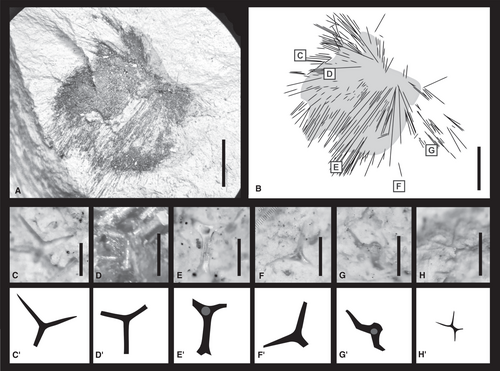
LSID
urn:lsid:zoobank.org:act:1B6399DF-E68D-480F-9249-7445A5A4221A
Derivation of name
The species name, milanek, refers to the diminutive of the name of the first author’s son, Milan; it is here used in apposition.
Type material
The holotype is a single, round and flattened specimen with spicules preserved in the original radial arrangement (ZPAL Pf. 31/4).
Type locality & horizon
Borehole no. 3 (depth 130.2 m), village of Spasskoye, middle Eocene.
Diagnosis
Globular sponge; skeleton consisting of bundles of oxeas with radial arrangement. No cortical specialization. Megascleres are predominantly large oxeas, calthrop-like triaenes and orthotriaenes.
Description
Sponge with globular (c. 10 mm) body and radially arranged spicules (Fig. 2A, B). Megascleres are long (at least 5 mm), straight oxeas that radiate from the centre of the sponge body. Beside oxeas, some calthrop-like triaenes (Fig. 2C–F) and, most probably, orthotriaenes with not fully (bulb-shaped) developed clads (Fig. 2G) occur.
Remarks
Most of the spicules probably are long oxeas, but due to the poor state of preservation of the tips, the presence of some long triaenes (e.g. orthotriaenes) cannot be ruled out. In many peripheral parts of the sponge body, as well as immediately next to the body, in the surrounding matrix, some spicule fragments and spicule imprints have been found. Most of these appear to be fragments or imprints of calthrop-like triaenes. A single orthotriaene in cross-sectional view has been seen as well; probably, with one of the clads not fully developed (bulb-shaped). Additionally, on the matrix surface an imprint of an amphitriaene has been noted; this may have belonged to the present specimen (Fig. 2H).
This taxon appears to possess features that are typical of the extant tetillid genus Paratetilla, namely a globular appearance with megascleres including calthrop-like short-shafted triaenes (van Soest & Rützler 2002), as well as orthotriaenes with bulb-shaped clads (e.g. Paratetilla arcifera in Santodomingo & Becking 2018, fig. 3h). Additionally, the probable presence of amphitriaenes characteristic of Amphitethya (van Soest & Rützler 2002) suggests that the present specimen may be a transitional form between those two modern tetillid genera. Paratetilla and Amphitethya are placed in close proximity on the phylogenetic tree (Szitenberg et al. 2013).
Palaeoecology
Modern-day tetillids are common in all oceans and at all depths.
Family SAMIDAE Sollas, 1888
Genus SAMUS Gray, 1867
Type species
Samus anonymus Gray, 1867, by monotypy
Samus anonymus Gray, 1867
Figure 3Q, R

Material
Moderately rare disassociated spicules, ZPAL Pf. 31/7.
Locality & horizon
Rybalsky quarry, Dnipro, upper Eocene.
Remarks
These are double triaenes with cladomes trifurcating, forwardly directed, away from short rhabd (Fig. 3Q, R). These are similar to spicules characterizing the extant species Samus anonymus, the sole taxon of the spirophorin family Samidae. The present spicules are c. 300–350 µm in length and appear to be larger than their modern counterparts, which may slightly exceed 150 μm (van Soest & Hooper 2002).
Palaeoecology
Modern S. anonymus has been recorded from shallow depths (up to 50 m; van Soest & Hooper 2002) along the coast of the Mediterranean Sea, the eastern coast of South America (Colombia, Brazil, Bermuda, and the Caribbean; Łukowiak 2016b; van Soest et al. 2021), the coasts of East and West Africa (van Soest et al. 2021) and from around Australia (Gray 1867; Carter 1879a; Wiedenmayer 1994).
Fossil record
Amphitriaenes have been recorded from Eocene strata of southern Australia (Łukowiak 2015) and the Miocene of Portugal (Pisera et al. 2006), Slovakia (Łukowiak et al. 2014), Italy (Costa et al. 2021) and the Bahamas (Palmer 1988).
Suborder ASTROPHORINA Sollas, 1887
Family GEODIIDAE Gray, 1867
Genus GEODIA Lamarck, 1815
Type species
Geodia gibberosa Lamarck, 1815, by monotypy
Geodia sp.
Figure 3A, B
Material
Moderately rare disassociated spicules, ZPAL Pf. 31/7.
Locality & horizon
Rybalsky quarry, Dnipro, upper Eocene.
Remarks
The most abundant spicule type that can be assigned to Geodia consists of sterrasters. These ovoid or spherical microscleres of considerable size (up to 150 × 125 μm) are characterized by stellate, tree-like terminations that are densely arranged on the spicule surface (Fig. 3A, B). In the present sterrasters, the stellate outgrowths are not preserved, although the unique character of this spicule type is visible. These spicules are characteristic for several geodiid genera (Uriz 2002) (e.g. Caminus Schmidt, 1862 and Pachymatisma Bowerbank in Johnston, 1842 (subfamily Erylinidae Sollas, 1888)), but in the majority of cases (nearly 95%) sterrasters belong to the genus Geodia (subfamily Geodiinae Sollas, 1888; compare with van Soest et al. 2012; Cárdenas 2020).
Palaeoecology
Generally, sponges of the family Geodiidae are common and widely distributed across the globe in bathyal, soft-bottom environments, but can also be found in caves and overhangs in the sublittoral zone (Uriz 2002; Cárdenas et al. 2011).
Fossil record
Spicules of extinct geodiid spicules have been recorded from various strata in many parts of the world (e.g. Wiedenmayer 1994), and sterrasters of Geodia first occur in upper Cretaceous strata (Cárdenas 2020). From the Cenozoic level, sterrasters have been described from Portugal (Pisera et al. 2006), Slovakia (Pisera & Hladilová 2004; Łukowiak et al. 2014), Italy (Frisone et al. 2014; Costa et al. 2021), North America (Rigby & Smith 1992), New Zealand (Hinde & Holmes 1892; Rich 1958), southern Australia (Łukowiak 2015) and the central Atlantic (Bukry 1978).
Genus ERYLUS Gray, 1867
Type species
Erylus mamillaris (Schmidt, 1862), by original designation
Erylus sp.
Figure 3C–E
Material
Rare disassociated spicules, ZPAL Pf. 31/7.
Locality & horizon
Rybalsky quarry, Dnipro, upper Eocene.
Remarks
Other spicules of sponges in the family Geodiidae (subfamily Erylinidae) are flattened ovoid discs with ornamented spicule surfaces; these are called aspidasters (Fig. 3C). The state of preservation of the present aspidasters is poor, their surface being corroded and the typical convex ornamentation replaced by small, hollow concavities (Fig. 3C). Spicules measure up to 320 × 200 μm in size. The present material also includes spicules of early growth stages (Fig. 3D, E); these are up to 250 × 120 μm in size, more flattened and have visible central canals protruding from the spicule centre to its margins. Both types of aspidasters can be assigned to the geodiid genus Erylus.
In addition to these, there are several other spicule morphotypes that may have belonged to geodiids, for example, the long protriaenes (up to 1100 μm; Fig. 3H–J), prodichotriaenes (up to 2200 μm; Fig. 3K–M) and styles (up to 800 μm; see Fig. 10E, F below). Unfortunately, this cannot be determined beyond doubt because they might be ascribed to other astrophorin sponges (e.g. families Ancorinidae Schmidt, 1870 or Pachastrellidae Carter, 1875) or to lithistids.
Palaeoecology
See above (genus Geodia).
Fossil record
Aspidasters are relatively common fossils that have been recorded from the Oligocene of Tasmania (Kennett in Kennett et al. 1975), the Miocene of Portugal (Pisera et al. 2006) and Italy (Costa et al. 2021), and the Eocene of New Zealand (Hinde & Holmes 1892). There is also a record from Holocene levels in Panama (Łukowiak et al. 2018).
Family ANCORINIDE Schmidt, 1862
Genus STELLETTA Schmidt, 1862
Type species
Stelletta grubii Schmidt, 1862, by subsequent designation
Stelletta sp.
Figure 3F, G
Material
Moderately abundant disassociated spicules, ZPAL Pf. 31/7.
Locality & horizon
Rybalsky quarry, Dnipro, upper Eocene.
Remarks
Large-sized plagiotriaenes with small clads and a squat, inflated (c. 2000 μm long) rhabd (Fig. 3F, G) resemble those of the ancorinid species Stelletta kundukensis Sim, 1996 (Sim 1996, figs 3, 4) or S. ventricosa (Topsent, 1904). The former occurs exclusively in the East China Sea and in Korean waters (van Soest et al. 2021), while the latter has been recorded solely from the Azores (van Soest et al. 2021).
Other triaenes (e.g. Fig. 3H, I, N) could also belong to this genus but a geodiid affinity cannot be ruled out.
Palaeoecology
Stelletta is a cosmopolitan genus, inhabiting shallow to bathyal depths (Uriz 2002).
Fossil record
Triaenes of similar morphology have previously been described from the Jurassic of the Swabian Alb, southern Germany (Reif 1967), the Upper Jurassic and Upper Cretaceous of Poland (Moczydłowska & Paruch-Kulczycka 1978), the Upper Cretaceous of northern Germany (Schrammen 1924), the Eocene of southern Australia (Łukowiak 2015) and the Miocene of Italy (Costa et al. 2021).
Genus TRIBRACHIUM Weltner, 1882
Type species
Tribrachium schmidtii Weltner, 1882, by monotypy
Tribrachium sp.
Figure 3O, P
Material
Very rare disassociated spicules, ZPAL Pf. 31/7.
Locality & horizon
Borehole no. 3 (depth 130.2 m), middle Eocene.
Remarks
Large-sized orthodiaenes with 1600-µm-long straight rhabds and moderately long (up to 550 µm) clads that are arranged almost perpendicularly to the rhabd (Fig. 3O, P) are nearly identical in size and shape to those of the extant ancorinid species, Tribrachium schmidtii Weltner, 1882 (Uriz 2002). Other spicules that characterize this species are also seen in the material studied, such as pro- and orthotriaenes (Fig. 3H–J, M), but it cannot be determined with certainty that these do belong to this genus. Another ancorinid species, Tethyopsis longispinus (Lendenfeld, 1907), has similar spicule types (compare with Koltun 1964).
Palaeoecology
Tribrachium schmidtii has been recorded exclusively from the central Atlantic (e.g. Greater Antilles, Brazil and Guyana) (van Soest et al. 2021) in shallow waters (<12 m), but it is also found at much greater depths, in excess of 700 m (Uriz 2002). Tethyopsis longispinus has been noted only from waters around Antarctica (van Soest et al. 2021).
Fossil record
With the exception of Łukowiak et al. (2019), we are not aware of any fossil record of spicules that are identical to those of the extant Tribrachium schmidtii.
PACHASTRELLIDAE Carter, 1875
PACHASTRELLIDAE gen. et sp. indet.
Figure 4A–H, L, S, T
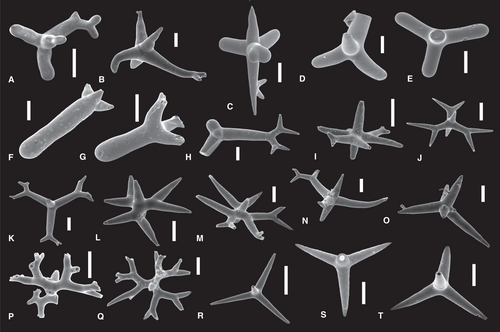
Material
Moderately abundant dissociated spicules, ZPAL Pf. 31/7.
Locality & horizon
Rybalsky quarry, Dnipro and borehole no. 1, upper Eocene; Vizirka and borehole no. 143, middle Eocene.
Remarks
Several tetraxial spicules in the present material are characterized by bulb-shaped tips. These are dichotriaenes (Fig. 4A, G, H), mesodichotriaenes (Fig. 4B, C, I) and triaenes (Fig. 4D–F), in which one or more tips is blunt. This kind of clad termination can be found in, for instance, pachastrellids such as Pachastrella scrobiculosa Lebwohl, 1914, P. ovisternata Lendenfeld, 1894, P. loricata (Lebwohl, 1914) and Characella ijimai (Lebwohl, 1914). However, the mesodichotriaenes of Figure 3I, J resemble those of the fossil pachastrellid Brachiaster claudelevii (Pisera & Bitner 2007, fig. 7c, d) which also possesses calthrops of a similar morphology to those in the present collection (Fig. 4R–T). Spicules with rounded tips also occur in other astrophorin groups, for example in Dercitus (Stoeba) senegalensis van Soest et al., 2010 (compare with van Soest et al. 2010, fig. 8b) and in geodiids (compare with Lendenfeld 1907, pl. 30, fig. 37), but those are characterized by rather longer rhabds than in the present spicules.
Palaeoecology
Pachastrellids are distributed worldwide, occurring mostly in epibathyal and bathyal habitats. However, a few encrusting or cavity-filling genera are known from shallow waters (Maldonado 2002).
Fossil record
Triaenes are quite common in the fossil record, having been recorded already from Cambrian and Ordovician sedimentary rocks (van Kempen 1990). There are also records from the Carboniferous of Scotland (Hinde 1887), the Triassic of the Alps (Mostler 1986), the Jurassic of southern Germany (Pisera 1997) and the Cenozoic of southern Atlantic (Ivanik 1983) and Slovakia (Łukowiak et al. 2014). Mesotriaenes of similar morphology are known from the Eocene of southern Australia (Pisera & Bitner 2007; Łukowiak 2015); some of these have been assigned to the genus Triptolemma Laubenfels, 1955 (see Łukowiak & Pisera 2017). Eocene sponges with round-tipped tetraxial spicules have also been noted as fossils and ascribed to the genera Pachastrella and Triptolemma (see Łukowiak & Pisera 2017). Calthrops are also quite common in the fossil record, with examples from the Jurassic of the Alps (Mostler 1990) and southern Germany (Pisera 1997).
Genus TRIPTOLEMMA Laubenfels, 1955
Type species
Triptolemma cladosum (Sollas, 1888), by original designation
Triptolemma sp.
Figure 4P, Q
Material
Moderately abundant dissociated spicules, ZPAL Pf. 31/7.
Locality & horizon
Rybalsky quarry, Dnipro, upper Eocene.
Remarks
Some short-shafted mesodichotriaenes with strongly branched clads (Fig. 4P, Q) are similar to spicules of the pachastrellid Triptolemma, especially to the Mediterranean species, T. simplex (Sarà, 1959) (compare with Bertolino et al. 2011, figs 1, 6a). Other spicules of tetraxial symmetry in the present material (Fig. 4K, M–O) might belong to this taxon.
Palaeoecology
Sponges assigned to the genus Triptolemma are cryptic in that they penetrate coral skeletons, other sponges, or inhabit crevices of coralligenous concretions (Maldonado 2002). Some species with similar mesodichotriaenes are found in relatively shallow waters, such as T. cladosum (Sollas, 1888) and T. strongylata Bertolino et al., 2011, which are known from depths of c. 200 m (Bertolino et al. 2011), and T. endolithicum van Soest, 2009 and T. simplex (Sarà, 1959), which are shallow water (<30 m) forms (van Soest 2009; Bertolino et al. 2011).
Fossil record
Similar spicules have been described from the Eocene of southern Australia by Łukowiak (2015) and of New Zealand by Hinde & Holmes (1892).
Family PHYMARAPHINIIDAE Schrammen, 1924
PHYMARAPHINIIDAE gen. et sp. indet.
Figure 5P, R
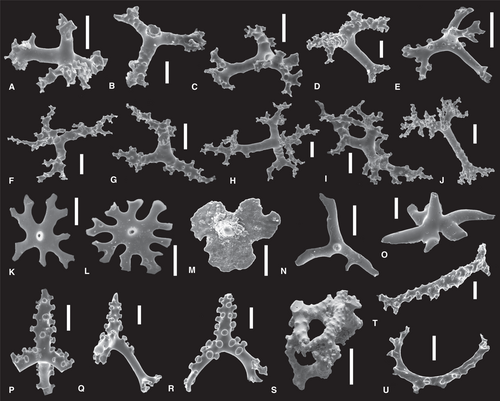
Material
Numerous dissociated spicules, ZPAL Pf. 31/7.
Locality & horizon
Boreholes no. 3 and no. 143, Rybalsky quarry, upper Eocene.
Remarks
Phymaraphiniid sponges are represented by loose trider desmas, which are very similar to those of the modern genus Exsuperantia Özdikmen, 2009 (Carvalho & Pisera 2019, figs 3e, 5d).
From the Palaeogene of Ukraine, Pisera (2000) described lithistid sponges with strongly tuberculated trider-like desmas that he attributed to the genus Plinthosella Zittel, 1878. Due to the absence of ectosomal spicules and data on the axial canal of desmas (i.e. monaxial Plinthosella; tetraxial in phymaraphiniids), it is difficult to corroborate such an attribution, but the new data suggest that this species also belonged to the Phymaraphiniidae, rather than to Plinthosellidae Schrammen, 1910.
Palaeoecology
Phymaraphiniids are common in the Cretaceous (Reid 2004a), but there are also records from the Eocene of southern Australia (Gammon et al. 2000; Łukowiak 2015), apparently from shallow water settings. Today, phymaraphiniids are known mostly from the northeast Atlantic Ocean, where they occur at depths of between 168 and 2011 m (Pisera & Lévi 2002a; Carvalho & Pisera 2019; Carvalho et al. 2020).
Fossil record
Phymaraphiniids first appeared during the Cretaceous, when they were diverse (seven genera and numerous species) and relatively large (Reid 2004a), while extant forms are rare, small and of limited diversity, with only two species known to date (Carvalho & Pisera 2019). However, at least two undescribed species are known from the Eocene of southern Australia (Gammon et al. 2000; Łukowiak 2015, AP, unpub. data).
Family THEONELLIDAE Lendenfeld, 1903
THEONELLIDAE gen. et sp. indet.
Figure 5A–O
Material
Abundant dissociated spicules, ZPAL Pf. 31/7.
Locality & horizon
Rybalsky quarry, Dnipro, borehole no. 1, upper Eocene.
Remarks
Apart from the whole-body sponge specimens, numerous loose tetraclone desmas have been found in matrix samples (Fig. 5A–J). These belong to at least two species, most probably those of which complete individuals are described below. We have also found isolated ectosomal phyllotriaenes (Fig. 5K–O) of a morphology that is markedly different from that observed in T. alexandriae Łukowiak, and may belong to unknown theonellids. However, it cannot be ruled out that some of these (e.g. Fig. 4K, L) belong to phymaraphiniid lithistids.
Palaeoecology
Modern theonellid sponges are known from both shallow and deep waters and rank among the few lithistids that are regularly found in very shallow waters (Zea 1987; Pisera & Lévi 2002b; Pisera & Pomponi 2015; AP, pers. obs.)
Fossil record
Lithistid demosponges characterized by tetraclone desmas and phyllotriaenes dermalia are known from at least the Early Cretaceous (Reid 2004a), having been assigned to various extinct families.
Genus THEONELLA Gray, 1868
Type species
Theonella swinhoei Gray, 1868, by monotypy
Theonella alexandriae Łukowiak sp. nov.
Figures 6, 7
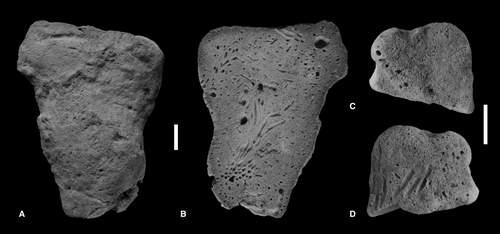
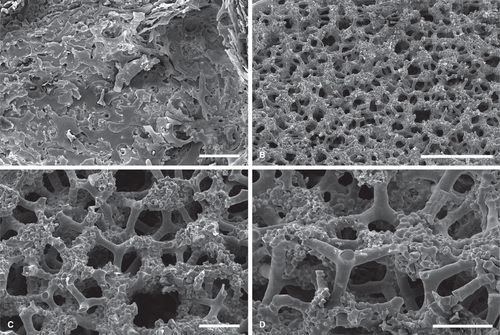
LSID
urn:lsid:zoobank.org:act:3B12DEFB-592C-4837-BD38-6AE4B020AB7F
Derivation of name
From the historical name, Alexandria, of the city of Kropyvnitskyi, in the vicinity of which these specimens have been collected.
Material
Two specimens, ZPAL Pf. 31/1 (holotype; Figs 6A, B, 7) and paratype ZPAL Pf. 31/2.
Type locality & horizon
Kropyvnitskyi quarry (Verblyuzhka), upper Eocene.
Diagnosis
Massive conical Theonella without visible spongocel but several small oscula, both apically and laterally. Numerous choanosomal canals, c. 1 mm in diameter, organized in two vague vertical and radial systems; choanosomal regular tetraclones, smooth and forming very large, strong articulations with several tetraclones to form globular articulation centres. Simple ectosomal phyllotriaenes with both rounded and pointed clad tips.
Description
The holotype is the larger specimen; it a massive conical, slightly compressed sponge, measuring 75 mm in height and 60 × 40 mm in apical diameter. No visible spongocel, but several small oscula apically and laterally. In cross-section, an unclear bunch of irregularly vertical canals and numerous irregularly radial canals of 1 mm in diameter. Ectosomal spicules are smooth, simple and irregular phyllotriaenes that have cladomes 210–285 μm in size with rounded to pointed cladome tips. Desmas are mostly smooth and regular tetraclones, 280–330 μm in size with c. 50-μm-thick arms with strongly branched tips that articulate with several other tips to form spherical articulations.
Remarks
Some isolated tetraclones in matrix (Fig. 5A–J) may belong to this species.
Pisera (2000) described another theonellid lithistid from Palaeogene strata in Ukraine under the name of T. ukrainica. The new species differs from this in habitus (being conical and massive, versus cylindrical and branched in T. ukrainica), in the arrangement of the choanosomal canal system (arranged in a vague axial and radial system versus a vertical bundle in T. ukrainica), as well as in the presence of more regular tetraclones. However, ectosomal phyllotriaenes are similar in both species, although the new species more often has rounded tips of clades.
Fossil record
The genus Theonella ranges from the Eocene to the present day, but there are numerous Cretaceous forms, described under different genus names, that may in fact belong to the genus Theonella.
Palaeoecology
See above, for theonellids.
cf. Lerouxia digitata Pisera, 2000
Figure 8
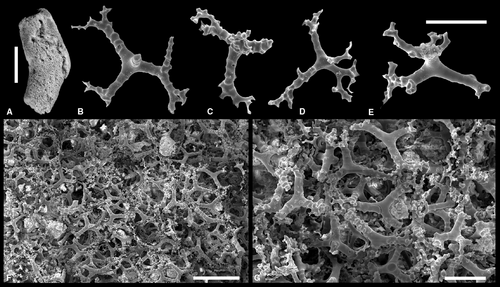
Material
One larger-sized fragmentary specimen and numerous small fragments, plus isolated tetraclone desmas, ZPAL Pf. 31/3.
Type locality & horizon
Rybalsky quarry, Dnipro, upper Eocene.
Description
Small, cylindrical (solid) fragment 25 mm in length and c. 7 mm in diameter. No spongocel; choanosomal skeleton consisting of irregular tetraclone desmas, 350–450 μm in size, with 40–50-µm-thick arms covered in ring-like tubercles in most cases; rarely smooth with branched arms and often irregular, thus resembling rhizoclones. Desmas relatively loosely articulated and forming an irregular skeleton.
Remarks
In the characteristics of the choanosomal skeleton and desmas, as well as habitus, this sponge resembles the lithistid from the Eocene of Ukraine that Pisera (2000) described as Lerouxia digitata. In view of the fact that the present material consists of small fragments only and that no ectosomal spicules have been found, this attribution is tentative at best. However, because differences between Theonella (extant) and Lerouxia (extinct Cretaceous) are not very clear, these specimens may represent only another species of Theonella. A few isolated tetraclones found in the matrix (Fig. 5F–J) may also belong to this species.
Rhizoclone-bearing lithistids
Figure 5T, U
Material
Rare dissociated spicules, ZPAL Pf. 31/7.
Type locality & horizon
Rybalsky quarry, Dnipro, upper Eocene.
Remarks
These sponges are relatively rare and are characterized by choanosomal desmas as rhizoclones, occurring both as isolated spicules and small flaky fragments. This poor state of preservation does not permit a more detailed taxonomic attribution.
Palaeoecology
Today, rhizomorine lithistids inhabit deep waters (Schuster et al. 2021), but rarely also shallow water submarine caves (e.g. Pérez et al. 2004; Manconi et al. 2006).
Fossil record
Lithistids with rhizoclone desmas that are identical to those of extant forms are common in the fossils record since the Jurassic (Reid 2004a). It is not clear how Palaeozoic (Ordovician–Devonian) rhizoclone-bearing lithistids (Finks & Rigby 2004) are related to Mesozoic–Recent forms with such spicules, due to the large time gap separating their respective occurrences.
Suborder THOOSINA Carballo et al., 2018
Family THOOSIDAE Cockerell, 1925
Genus ALECTONA Carter, 1879b
Type species
Alectona millari Carter, 1879b, by monotypy
Alectona millari Carter, 1879b
Figure 9R–T
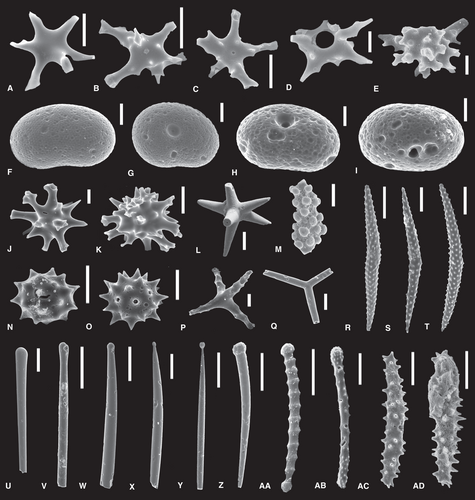
Material
Rare disassociated spicules, ZPAL Pf. 31/7.
Locality & horizon
Rybalsky quarry, Dnipro, upper Eocene.
Remarks
The present sample contains rare strongyloxeas; these average-sized spicules (up to 500 μm in length) possess numerous minute tubercles that are regularly arranged in longitudinal rows along the spicule (Fig. 9R–T). This spicule type is referable to the thoosid genus Alectona, especially to the extant species Alectona millari (compare with Rützler 2002a, fig. 2). Unfortunately, other spicule types characteristic of this modern species (i.e. small, spiny or smooth oxeas, and amphiasters with a fusiform, microspined shaft) have not been observed in out material. The only feature that differentiates the fossil and modern spicules is size: the former strongyloxeas are larger than those of modern Alectona, which measure 225–370 μm in length (Rützler 2002a).
Palaeoecology
Alectona millari bores into coral skeletons and has been recorded from rather shallow depths (e.g. 54 m, 202 m; Rützler 2002a) all around the Mediterranean Sea, the Azores and the northern coasts of the British Isles as well as from Australia (van Soest et al. 2021).
Fossil record
Łukowiak (2015) described strongyloxeas of A. millari from the Eocene of southern Australia; Hinde & Holmes (1892) recorded similar spicules from the Eocene of New Zealand.
Alectona wallichii (Carter, 1874)
Figure 9M
Material
A single spicule fragment, ZPAL Pf. 31/7.
Locality & horizon
Vizirka quarry, middle Eocene.
Remarks
These highly characteristic mushroom-shaped knobs (Fig. 9M) appear to be part of a diactinal spicule of Alectona wallichii (compare with Vacelet 1999, fig. 1c–f). In this type the knobs cover the entire spicule, forming well-defined longitudinal rows of tubercles. Spicule thickness exceeds 130 μm and the knobs are c. 50 μm in diameter. Tuberculate diactines of Alectona wallichii are highly distinctive and cannot be confused with spicules of any other sponge, including other thoosids (compare with Łukowiak 2016b).
Palaeoecology
Most alectonid sponges live hidden inside burrows made in scleractinians, calcareous algae, or octocorals (Rosell 1996; Rützler 2002a) and have been recorded from shallow depths of a few metres (Vacelet 1999; Sunil Kumar & Thomas 2012) down to c. 150 m (Vacelet 1999).
The present species has been noted from the Mediterranean, the North Atlantic and Indian Ocean (Bavestrello et al. 1998; Sunil Kumar & Thomas 2012), the Sea of Japan (van Soest et al. 2021), South Africa, and Hawaii (Vacelet 1999). Spicules of identical morphology have also been recorded from sediment samples from the Caribbean Sea (Łukowiak 2016b).
Fossil record
Spicules resembling those of A. wallichii have been described from the Miocene of Portugal (Pisera et al. 2006) and the Vienna Basin, Slovakia (Łukowiak et al. 2014). There are also some alectonid-like spicules known from the Miocene of the Bahamas (Bukry 1978).
Order SPHAEROCLADINA Schrammen, 1924
Family VETULINIDAE Lendenfeld, 1903
Genus VETULINA Schmidt, 1879
Type species
Vetulina stalactites Schmidt, 1879, by monotypy
Vetulina sp.
Figure 9A–E
Material
Common dissociated spicules and flaky fragments, ZPAL Pf. 31/7.
Locality & horizon
Rybalsky quarry, Dnipro, upper Eocene.
Remarks
These sponges are represented only by small flaky fragments and loose spicules. The latter comprise strongly corroded sphaeroclones. Young spicules of this genus, which are characterized by the presence of a hole in the centre, appear in the present assemblage as well (Fig. 9A–E). Despite the poor preservation, their morphology is sufficiently characteristic for genus-level attribution.
Palaeoecology
Five modern species of Vetulina are on record from the Philippines (in crevices; at a depth of 7 m; Schuster et al. 2018), Australia (90–108 m; Pisera et al. 2017) and the Caribbean (180–220 m; e.g. Pomponi et al. 2001; Pisera & Lévi 2002c; Pisera et al. 2017; Schuster et al. 2018).
Fossil record
Although sphaeroclone-bearing lithistids are common in the Mesozoic, there is no reliable fossil record of the genus Vetulina (Pisera et al. 2017). In palaeontological textbooks, the family Vetulinidae includes c. 10 genera from the Mesozoic (Jurassic and Cretaceous; Reid 2004a) and one from Palaeogene strata (i.e. the sole record from the Eocene of Italy; Frisone et al. 2016). However, they are mostly massive in habitus and no isolated ectosomal spicules are known.
Order CLIONAIDA Morrow & Cárdenas, 2015
Family PLACOSPONGIIDAE Gray, 1867
Genus PLACOSPONGIA Gray, 1867
Type species
Placospongia melobesioides Gray, 1867, by original designation
Placospongia sp.
Figure 9F–I
Material
Moderately abundant dissociated spicules, ZPAL Pf. 31/7.
Locality & horizon
Rybalsky quarry, Dnipro, upper Eocene.
Remarks
Selenasters found in the present material are ovoid, bean-shaped spicules with short irregular rays and/or rounded polygonal plates between the grooves (Fig. 9F–I). This spicule type is known in only a single modern placospongiid genus, Placospongia (van Soest 2009; Rützler 2002b). In spite of the fact that these have previously been considered as microscleres (Rützler 2002b), these spicules are of considerable size, measuring up to 110 × 80 μm.
Palaeoecology
Placospongiids, massive encrusting or branching forms, can be found in shallow tropical and subtropical waters, from the intertidal zone to depths of almost 200 m (Rützler 2002b). The nine known species of Placospongia have been recorded globally (e.g. Japan, Indonesia, the Caribbean, East African coasts, Mediterranean Sea and the Azores; van Soest et al. 2021).
Fossil record
Spicules of Placospongia have been recorded from many strata; for example, from the Jurassic (Hinde 1883; Schrammen 1936; Hartman 1980; Trammer 1982 (described as ‘rhax’); Pisera 1997) and Cretaceous (Carter 1871; Gruber & Reitner 1991). Cenozoic records include the Eocene of Australia (Hinde 1910, geodiid sterrasters; Łukowiak 2015) and Italy (Frisone et al. 2014), and the Miocene of the central Atlantic (Bukry 1978).
Family SPIRASTRELLIDAE Ridley & Dendy, 1886
Genus DIPLASTRELLA Topsent, 1918
Type species
Diplastrella bistellata (Schmidt, 1862), by original designation
Diplastrella megastellata Hechtel, 1965
Figure 9J, K
Material
Moderately abundant dissociated spicules, ZPAL Pf. 31/7.
Locality & horizon
Rybalsky quarry, Dnipro, upper Eocene.
Remarks
The type of euaster called an anthaster possesses rays with branched tips. These exceed 110 μm in diameter and (despite the fact that some of their rays are broken) the bifurcating expansions of their tips are visible (Fig. 9J, K). These spicules characterize the spirastrellid species D. megastellata (Rützler 2002c). Although spicules of extant D. megastellata seem to be smaller (up to 80 μm), their morphology is very similar (compare Rützler et al. 2014, fig. 19b).
In the present material there are also some 600-µm-long tylostyles with a small globular swelling (tyle) at one end (Fig. 9Y). These are similar in size to those of D. megastellata (compare Hechtel 1965, fig. 12a).
Palaeoecology
These spirastrellids are common in shaded subtropical and shallow tropical waters of 10 m in depth, for instance, in coral reefs (Hechtel 1965; Rützler 2002c). Today, they are known from the Caribbean and the eastern coasts of South America (van Soest et al. 2021).
Fossil record
Despite the fact that Recent sponges with this type of anthaster are restricted to the Caribbean and eastern South America, the fossil record includes anthasters in many parts of the world. For example, they have been recorded from the Miocene of Slovakia (Łukowiak et al. 2014) and Portugal (Pisera et al. 2006) and the Oligocene of Tasmania (Kennett in Kennett et al. 1975). In Eocene strata, they have been described from New Zealand (Hinde & Holmes 1892) and Australia (Hinde 1910; Łukowiak 2015; Łukowiak & Pisera 2017).
Order POECILOSCLERIDA Topsent, 1928
Family ACARNIDAE Dendy, 1922
Genus ZYZZYA Laubenfels, 1936
Type species
Zyzzya fuliginosa (Carter, 1879a), by original designation
Zyzzya sp.
Figure 9AA
Material
Very rare dissociated spicules, ZPAL Pf. 31/7.
Locality & horizon
Rybalsky quarry, Dnipro, upper Eocene; Vizirka quarry, middle Eocene.
Remarks
Slender verticillate acanthostrongyles are diactinal spicules with coils of minute tubercles arranged along the shaft (Fig. 9AA). The number of whorls of tubercles over the shaft is c. 10. They are also characterized by spiny, well-defined heads, up to 180 μm in length. This type of spicule appears in two species of modern acarnids, Zyzzya papillata Thomas, 1968 and Z. invemar van Soest et al., 1994. In the former, the number of whorls of tubercles is smaller than in the latter and varies between 10 and 15. The size is also comparable with that of the fossil spicules (compare Thomas 1968) and there is a resemblance to spicules of the excavating Dotona pulchella mediterranea Rosell & Uriz, 2002, but those are stouter and the whorls of tubercles are spirally arranged along the spicules (Rosell & Uriz 2002).
Palaeoecology
Zyzzya papillata has been noted from very shallow waters (3 m; Thomas 1968), and has been recorded in South India and Sri Lanka only (van Soest et al. 2021).
Fossil record
Similar verticillate acanthostrongyles are known from the Carboniferous and Permian (Mostler 1994). The same author had earlier recorded such spicules from the Jurassic of the Alps (Mostler 1990), while Schrammen (1924) noted verticillate acanthostrongyles from the Upper Cretaceous of northern Germany. From the Cenozoic sedimentary rocks, this type of strongyle is known from the Miocene of the Bahamas (Bukry 1978) and the Eocene of southern Australia (Hinde 1910; Łukowiak 2015) and New Zealand (Hinde & Holmes 1892).
Family MYXILLIDAE Dendy, 1922
Genus ECTYONOPSIS Carter, 1883
Type species
Ectyonopsis ramosa Carter, 1883, by monotypy
Ectyonopsis sp.
Figure 9AB
Material
A single spicule, ZPAL Pf. 31/7.
Locality & horizon
Rybalsky quarry, Dnipro, upper Eocene.
Remarks
This acanthostrongyle with irregularly arranged small spines that become more crowded at the spicule heads may be of myxillid affinity, resembling in particular spicules of some species of Ectyonopsis (compare E. ramosa Carter, 1883 and E. flabellata (Lévi, 1963) in van Soest 2002a).
Palaeoecology
Ectyopsis ramosa has been recorded from Australia. Other species are also known from distant parts of the world, such as Antarctica and the western coast of central America (van Soest et al. 2021).
Fossil record
Similar spicules have been recorded form the Jurassic of the Alps by Mostler (1990) and from the Miocene of Slovakia by Łukowiak et al. (2014).
Order AGELASIDA Hartman, 1980
Family AGELASIDAE Verrill, 1907
Genus AGELAS Duchassaing de Fonbressin & Michelotti, 1864
Type species
Agelas dispar Duchassaing de Fonbressin & Michelotti, 1864, by subsequent designation
Agelas sp.
Figure 10J
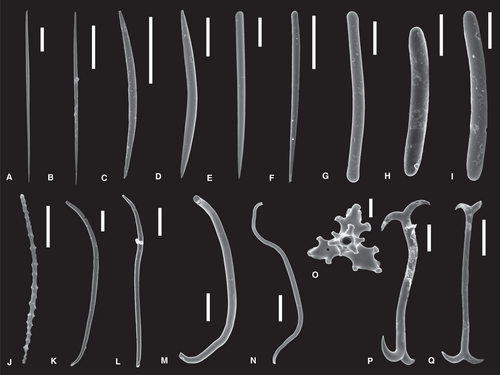
Material
Rare dissociated spicules, ZPAL Pf. 31/7.
Locality & horizon
Rybalsky quarry, Dnipro, upper Eocene.
Remarks
There are some styles equipped with parallel whorls of spines along their length (Fig. 10J), these styles are quite large, exceeding 400 μm in length, and closely resemble Recent agelasid spicules called verticillate acanthostyles. There are two families in this order that are characterized by verticillate styles, namely the Agelasidae and Astroscleridae (Vacelet 2002; van Soest 2002b). The present verticillate acanthostyles are quite slender, up to 400 μm in length, and slightly bent (Fig. 10J); they resemble spicules of the South American agelasid Agelas dispar Duchassaing de Fonbressin & Michelotti, 1864, as illustrated by Mothes et al. (2007, fig. 6).
Palaeoecology
Sponges of the genus Agelas are typically found in tropical waters, with the greatest diversity known from the Caribbean Sea, followed by the Indo-Pacific Ocean and the Mediterranean Sea; for example, Agelas oroides (Schmidt, 1864).
Fossil record
Fossil spicules of agelasid sponges have already been recorded from the Permian of Texas by Mostler (1994). Several other spicules of similar morphology were illustrated by Schrammen (1924) from the Upper Cretaceous of northern Germany, but without precise assignment. From the Eocene of southern Australia, Łukowiak (2015) described several types of agelasid spicules, while Bukry (1978) had recorded agelasids from the Miocene of the central Atlantic and Łukowiak et al. (2014) from the Miocene of the central Paratethys (Slovakia).
Order BUBARIDA Morrow & Cárdenas, 2015
BUBARIDA gen. et sp. indet.
Figure 10K–N
Material
Moderately rare dissociated spicules, ZPAL Pf. 31/7.
Locality & horizon
Rybalsky quarry, Dnipro, upper Eocene; Borehole no. 3 (depth 131.15 m), middle Eocene.
Remarks
In the present material occur asymmetrical, flexuous oxeas (Fig. 10K–N); most of these are broken. Complete ones measure up to 1250 μm in length and 50 μm in thickness. This type of oxea might belong to sponges of two heteroscleromorph orders: Axinellida or Bubarida. However, assignment to the latter is more plausible, because some bubarids (e.g. Acanthella Schmidt, 1862) are characterized by quite large, flexuous diactinal spicules (Alvarez & van Soest 2002).
Palaeoecology
Bubarids are distributed worldwide and more than 20 species of Acanthella are known to inhabit the Mediterranean Sea (Alvarez & van Soest 2002).
Fossil record
Mostler (1986) illustrated flexuous diactin spicules from the Triassic of the Alps, while some flexuous anisoxeas were recorded by Reif (1967) from the Jurassic of southern Germany, yet without any systematic assignment. Anisoxeas of the same type as studied here have also been described from the Eocene of southern Australia (Łukowiak 2015; Łukowiak & Pisera 2017).
Other ‘soft’ demosponge spicules
Figures 9L, N, O, Q–T, 10A–I, O
Remarks
Apart from sponge spicules in the present material that could be attributed taxonomically relatively easily, there are some morphotypes for which a precise assignment is not possible. Such are oxeas (Fig. 10A–D), styles (Fig. 10E, F), strongyles (Fig. 10G–I), tylostyles (Fig. 9V–Z), oxyasters and oxyspherasters (Fig. 9N, O), astrose spicules (Fig. 9L, P), and a single triod (Fig. 9Q).
Most of these types may belong to a wide array of sponge taxa. For example, oxeas are found in various demosponge groups such as the order Haplosclerida families Geodiidae, Spirasigmidae and Tetillidae (Hooper & van Soest 2002). Strongyles characterize the families Petrosiidae and Geodiidae, and tylostyles are typical of Polymastiidae and Clionaidae (Hooper & van Soest 2002). The sanidasters (Fig. 9AC, AD) resemble spicules of modern species of Acanthotetilla such as A. gorgonasclera van Soest, 1977, or A. enigmatica (Lévi, 1964) (compare van Soest 1977, pl. 2a, b), but this is a very speculative assignment given that similar spicules can be found in a few species of the coleosphaerid Histodermella Lundbeck, 1910 and in some lithistids. The oxyaster and oxyspheraster (Fig. 9N, O) might belong to some geodiids but a chondrillid affinity cannot be excluded either. The astrose spicules (Fig. 9L, P) may be attributed to an astrophirin such as Stelletta or Geodia. The affinity of the triod (Fig. 9Q) cannot be established in greater detail beyond Astrophorida.
Class HOMOSCLEROMORPHA Bergquist, 1978
Order HOMOSCLEROPHORIDA Dendy, 1905
Family PLAKINIDAE Schulze, 1880
Genus PLACINOLOPHA Topsent, 1897
Type species
Placinolopha bedoti Topsent, 1897, type by monotypy
Placinolopha sarai Lévi & Lévi, 1989
Figure 10P, Q
Material
Rare dissociated spicules, ZPAL Pf. 31/7.
Locality & horizon
Rybalsky quarry, Dnipro, upper Eocene.
Remarks
The present material includes only rare examples of plakinid spicules; these are amphiclads with two opposed cladomes curved backwards in the same plane (Fig. 10P, Q), of a length of c. 600 μm. This type of spicule is observed in two Recent homoscleromorph species, Placinolopha sarai and P. moncharmonti (Sarà, 1960). Spicules of the former measure 770–880 μm in length (Lévi & Lévi 1989), while those of the latter are smaller, c. 400 μm long (Sarà 1960). Considering the size of the fossil spicules, these may be attributed to P. sarai.
Palaeoecology
Plakinids in the eastern Philippines occur at a depth of c. 85–90 m (van Soest et al. 2021).
Fossil record
Amphiclads of Placinolopha cf. sarai had been described earlier only from the upper Eocene of southern Australia (Łukowiak 2015).
Class HEXACTINELLIDA Schmidt, 1870
Subclass HEXASTEROPHORA Schulze, 1886
HEXACTINOSA gen. et sp. indet.
Figure 11

Material
Several fragments of dictyonal skeleton and loose hexactines/pentactines, ZPAL Pf. 31/7.
Locality & horizon
Borehole no. 143, upper and middle Eocene.
Remarks
Loose pentactines and hexactines (Fig. 11A–C) may belong to Hexactinosa or to Lyssacinosa. Fragments of complex dictyonal skeleton (Fig. 11D–F) belong to Hexactinosa, most probably to the Euretidae or Tretodictyidae. Dictyonal skeletons with one skeletal layer most probably belong to the Farreidae (Fig. 11G). In this sample at least two species are represented, judging from the skeletal architecture and sculpture.
Palaeoecology
Hexactinellids are usually deep water inhabitants. However, under special conditions they may occur in shallower settings (Leys et al. 2007).
Fossil record
Undoubted hexactinosid sponges are known since the Triassic, being common from the Jurassic onwards (Reid 2004b). Several genera, closely resembling Mesozoic and Recent forms, however, occur in the Palaeozoic (Late Ordovician to Late Devonian) (Rigby et al. 2001; Finks & Rigby 2004), but their relationship with Mesozoic forms is obscured because of the large time gap separating them.
Family APHROCALLISTIDAE Gray, 1867
Genus APHROCALLISTES Gray, 1858
Type species
Aphrocallistes beatrix Gray, 1858, by monotypy
Aphrocallistes sp.
Figure 12
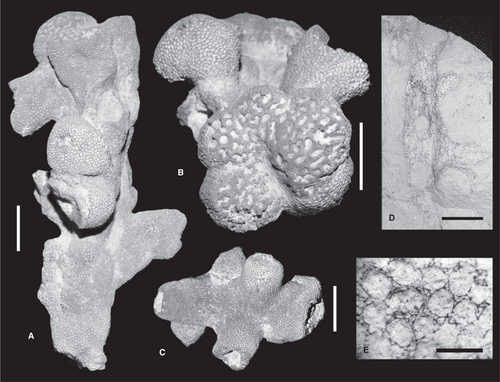
Material
Three specimens: MB.Po.2784, MB.Po.2785 and ZPAL Pf. 31/5.
Locality & horizon
Borehole no. 3 (depth 130.4 and 131.15 m), middle Eocene; blue clays, Dnieper River near Kiev, middle Eocene.
Remarks
These sponges form a funnel-like axis with side branches radiating from the axis; they may be open with small secondary oscula, but in most cases they are closed. Specimens measure up to 80 mm in height and 35 mm at the apex, with branches of 8–10 mm in diameter and a length of 13 mm. The main osculum at the top is covered with a sieve plate. The choanosomal skeleton is organized in a characteristic honeycomb pattern. Specimens from outcrops near Kiev are entirely pyritized and those from boreholes are either pyritized or flattened with a crushed skeleton, not allowing detailed study. However, the morphology of the skeletal features of this genus are such that there can be no doubt of the attribution. The specimens shown in Figure 12A–C are identical in habitus to the extant Aphrocallistes vastus Schulze, 1886 (Reiswig 2002, fig. 2A) and also very similar to the Late Cretaceous A. cylindrodactylus Schrammen, 1912.
Palaeoecology
This extant genus, with a worldwide distribution, is among those hexactinellids that inhabit depths of up to 2948 m, but are most often found at relatively shallow depths of 60 m (Reiswig 2002; Reiswig & Kelly 2011).
Fossil record
This genus ranges from the Early Cretaceous (Reid 2004b) to the present day. Eocene occurrences are known from Catalonia (Pisera & Busquets 2002) and North Carolina (Finks et al. 2011, as Druidia) and there are Oligocene records from Washington and Oregon (Rigby & Jenkins 1983).
Discussion
Diversity of the sponge fauna from the Middle Dnieper region
Our study of dissociated spicules and preserved whole-body sponges from the middle–upper Eocene of east-central Ukraine has revealed a surprisingly diverse sponge fauna. Members of three sponge classes are represented: Demospongiae are the most diverse, with at least 31 species in 26 families, followed by Hexactinellida (three species), and Homoscleromorpha (one species). The assemblage further provides evidence of the presence of two new demosponge species, established here as Paratetilla milanek Łukowiak and Theonella alexandriae Łukowiak, and the first fossil record of Vetulina. The diversity of the middle Eocene sponge community of the western Tethys is lower than that of the late Eocene (Table S1). However, this lower number of recognized sponge taxa in the middle Eocene assemblage could be due to a sampling bias, given that upper Eocene outcrops outnumbered the middle Eocene ones and the lithology of lower Eocene strata did not permit the simple extraction of isolated spicules.
The only other assemblages of Eocene age that show a diversity similar to that described here are those from southern Australia (Hinde 1910; Łukowiak 2015, 2016a; Łukowiak & Pisera 2017) and New Zealand (Hinde & Holmes 1892; Edwards 1991; Kelly et al. 2003; Kelly & Buckeridge 2005), and are of late Eocene age. The New Zealand Oamaru Diatomite has yielded a diverse assemblage of spicules that have been assigned to at least 112 species of siliceous sponges (including 92 demosponge species; Hinde & Holmes 1892; Łukowiak 2016a). Material from southern Australia, in turn, contained at least 65 siliceous sponge species, including at least 52 species of ‘soft’ demosponges (Łukowiak 2016a; Łukowiak & Pisera 2017). Additionally, numerous, mostly undescribed, lithistid species are present (Gammon et al. 2000; AP, unpub. data). The southern Australian assemblage is interpreted to have inhabited waters of c. 100 m in depth, in contrast to the deeper New Zealand assemblage (Łukowiak 2016a).
Bathymetry
The taxa recognized in the Eocene of east-central Ukraine currently occupy depths ranging from a few metres down to 150–200 m. Therefore, we hypothesize that the assemblage studied inhabited shallow waters with an estimated depth of c. 100 m. The shallow water taxa from the middle Eocene, such as Alectona wallichii, are replaced in the late Eocene by other shallow water inhabitants, including Alectona millari, Samus anonymus, Agelas sp., Diplastrella megastellata, Placinolopha sarai, Merlia sp. and Dotona sp. (see Appendix S1 for a list of taxa from the Eocene of east-central Ukraine). Other sponges in the upper Eocene deposits have a wide bathymetric range in the present day. For instance, phymaraphiniids inhabit depths of c. 170–700 m (Pisera & Lévi 2002a; Carvalho & Pisera 2019), Tribrachium has been recorded from depths of between 12 and 2000 m (Uriz 2002) and Aphrocallistes can be found at depths of c. 60–2948 m (Reiswig & Kelly 2011) (Table S1). Still, they can be characterized as relatively shallow water taxa. Sponges of the Rhizomorina group are also indicative of deep water settings (Pisera & Lévi 2002b), but may rarely be found in shallow waters as well (Pérez et al. 2004).
Palaeobiogeography
During the Palaeogene the diversity of sponge faunas in the western Tethys, southern Australia and New Zealand was relatively rich. In addition, the homogeneity of these assemblages is higher than expected, given that there are several species in common between these areas (e.g. Alectona millari, Diplastrella megastellata, Samus anonymus, Placinolopha sarai, and probably also Janulum sp., Merlia sp. and Triptolemma sp.). This suggests that these taxa may have been very broadly distributed at that time (Fig. 13). Some of these taxa have close relatives in the modern Mediterranean Sea (e.g. Triptolemma sp., Alectona millari, Alectona wallichii, Merlia sp. and Samus anonymus). However, some others (e.g. Ectyonopsis, Tribrachium, Zyzzya, Histodermella sp., Vetulina sp., Placinolopha sarai and Diplastrella megastellata) have not been observed in the Mediterranean Sea. The five species of Vetulina are now found in the Caribbean Sea, the Philippines, and Australia (Fig. 13; Schuster et al. 2018). In turn, P. sarai is known only from the eastern Philippines (van Soest et al. 2021) and D. megastellata is reported today from the Caribbean and the eastern coasts of South America (van Soest et al. 2021). Apparently, their populations first occupied a wider area and might have shrunk in distribution since the late Eocene (Fig. 13).
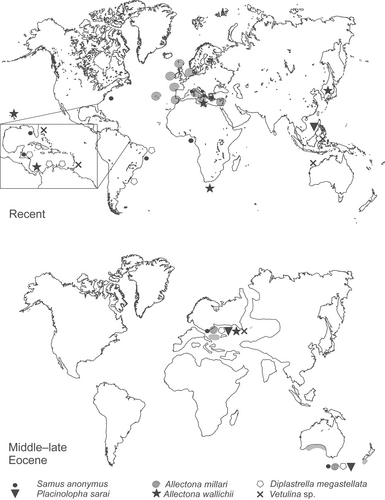
With respect to taxic diversity, the sponge assemblage studied displays a greater similarity to that of the peri-Australian region than to that of the westernmost areas of the Tethys Ocean. The sponge community from the Lutetian (lower middle Eocene) of northern Italy consists mostly of lithistids and hexactinellids that inhabited deeper waters, and it had more of a ‘Cretaceous character’ (Matteucci & Russo 2005; Frisone et al. 2016). The range of some of the sponge taxa recorded from there extends downwards into the Cretaceous (e.g. Ventriculites) and the Jurassic (e.g. Camerospongia) or even the Triassic (e.g. Astrosclera). The present fauna seems not to have any taxa common with those recorded by Matteucci & Russo (2005) and Frisone et al. (2016). The Italian assemblage appears to share more similarities with that from the Bartonian (upper middle Eocene) of Catalonia (Pisera & Busquets 2002), which was part of an East Atlantic Province at that time (Hou & Li 2018). Many of the taxa described from Catalonia by Pisera & Busquets (2002) are also present in the assemblage described by Matteucci & Russo (2005) and Frisone et al. (2016), namely Laocoetis patula Pomel, 1872, Callicylix aff. eocenicus Pisera & Busquets, 2002 and Centrosia aff. viquensis Pisera & Busquets, 2002 (Matteucci & Russo 2005; Frisone et al. 2016). In turn, the coeval fauna from northern Italy, reconstructed on the basis of dissociated spicules and described by Frisone et al. (2014), shares some taxa with the Ukraine faunules. For example, verticillate acanthostrongyles of Zyzzya and sterrasters of Geodia are present in both the northern Italy fauna and Ukraine faunules (Frisone et al. 2014). Generally, these sponge assemblages appear to have more deep water characters than the material recorded here.
Differences, however, in taxonomic composition between the material described here and that of Pisera & Busquets (2002), Matteucci & Russo (2005) and Frisone et al. (2016) may stem from differences in the available data: the Catalonian and Italian assemblages consist mostly of preserved whole-body sponges with fused (hexactinellids) and articulated (lithistids) skeletons. Loose spicules were either not extracted or did not occur in the sediments. Frisone et al. (2014) were the only ones to describe dissociated spicules and thus that fauna shows the highest degree of similarity to the fauna described here.
Conclusion
A diverse middle–late Eocene sponge fauna from east-central Ukraine contains at least 28 families, 26 genera and 35 species of siliceous sponges in three sponge classes. At least 32 demosponge species, including two new ones, Paratetilla milanek Łukowiak and Theonella alexandriae Łukowiak, as well as three hexactinellid and one homoscleromorph are represented. A fossil example of the lithistid sponge genus Vetulina is also included. It is suggested that the sponge fauna studied inhabited shallow waters at a depth of c. 100 m; it shares numerous species with the late Eocene Australian and New Zealand assemblages, thus showing that during the early Palaeogene sponge faunas were rather homogeneous.
Acknowledgements
The present study was financially supported by a National Science Centre Grant no. 2016/21/B/ST10/02332 to AP. We thank Daniel Madzia (IP, PAS) for English-language editing. MŁ thanks her son, Milan, for his patience during the preparation of this manuscript, which was written in home-office mode during the COVID-19 pandemic. We also thank Dr Anatoly Berezovsky for the sponge spicule material and the preserved whole-body sponges from Vizirka Quarry and from the village of Verblyuzhka; and Grażyna Dziewińska (IP, PAS) for macrophotographs of some of the studied specimens. Thanks are also due to the Editor, Dr John Jagt, and Dr Viviana Frisone for their constructive comments.
Author contributions
Conceptualization M. Łukowiak, A. Pisera; Funding Acquisition A. Pisera; Investigation M. Łukowiak, A. Pisera, T. Stefanska, V. Stefanskyi; Methodology M. Łukowiak, A. Pisera; Resources M. Łukowiak, A. Pisera, T. Stefanska, V. Stefanskyi; Supervision M. Łukowiak, A. Pisera; Validation M. Łukowiak, A. Pisera, T. Stefanska, V. Stefanskyi; Visualization M. Łukowiak, A. Pisera; Writing – Original Draft Preparation M. Łukowiak (establishment of Paratetilla milanek sp. nov. and Theonella alexandriae sp. nov.; systematic assignment of dissociated spicules, except hexactinellids and lithistids), A. Pisera (systematic assignment of hexactinellids and lithistids, both whole-body preserved specimens and spicules); Writing – Review & Editing M. Łukowiak, A. Pisera, T. Stefanska, V. Stefanskyi.
Open Research
Data archiving statement
This published work, and the nomenclatural acts it contains, have been registered in ZooBank: http://zoobank.org/References/C4A4E141-9475-496F-9A0C-69B9594FD0F6



